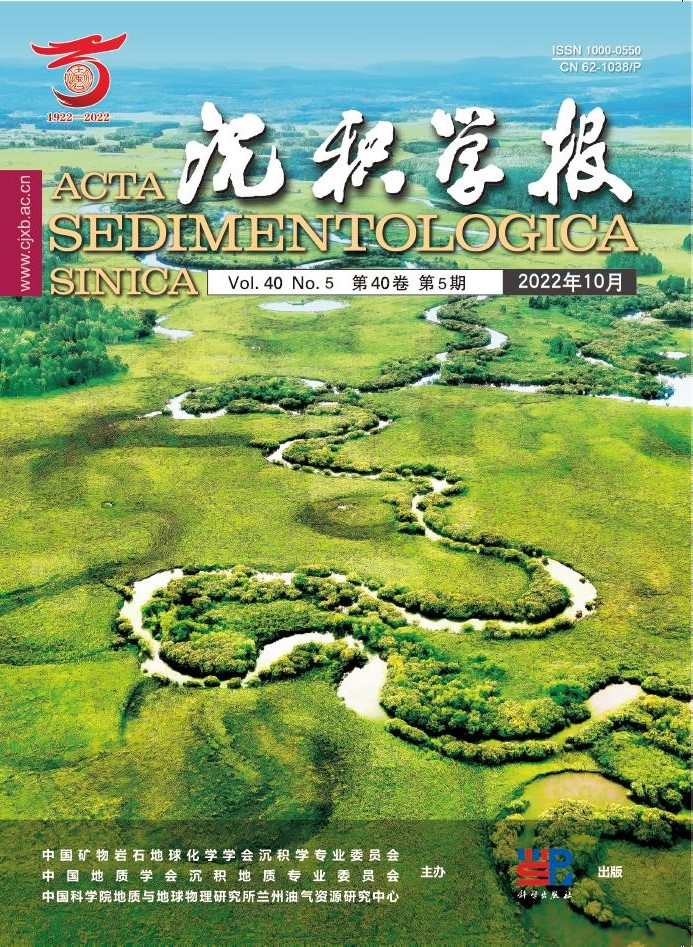HTML
-
环境磁学是地球科学、环境科学等领域的重要研究手段,具有测量快速、简便、非破坏性等优点[1-3]。环境磁学主要通过定性或定量识别沉积物等环境介质的磁性特征来提取物源、分选、污染、次生改造等信息[1-2]。沉积物磁性特征主要体现在磁性矿物的类型及组合、含量和颗粒三个方面。一般较高含量和比例的亚铁磁性矿物(如磁铁矿)会导致沉积物具有较高的磁化率(χ)、饱和等温剩磁(SIRM)、退磁参数(S-ratio),而赤铁矿等不完整反铁磁性矿物的含量或比例增加会降低χ、SIRM、S-ratio[4-5]。
磁性颗粒特征是环境磁学研究的重要内容,具有重要环境意义,可以应用于现代地理环境和古环境研究[1-3]。如在河流、河口海岸、湖泊、黄土等沉积环境中,可通过磁性颗粒大小提取沉积动力变化[6]、古气候变化[7]、降水变化[8]等信息。磁性矿物按照颗粒大小分为:超顺磁性颗粒(SP,<0.03 μm)、稳定单畴颗粒(SSD,0.03~0.1 μm)、假单畴颗粒(PSD,0.1~10 μm)和多畴颗粒(MD,>10 μm)[9]。相同类型磁性矿物在不同颗粒状态下磁性特征表现迥异,χ对SP颗粒最为敏感,MD颗粒次之;而SIRM则对SD颗粒较为敏感[10]。非磁滞剩磁磁化率(χARM)也对磁性颗粒大小很敏感,SD颗粒磁性矿物的χARM要显著高于SP和MD颗粒[10]。因此当沉积物中磁性矿物的颗粒较粗时,比值参数χARM/χ、χARM/SIRM表现为低值,而当沉积物中磁性矿物的颗粒较细时,表现为高值[2,9-10]。
本研究对中亚地区历史上最大的湖泊罗布泊盐湖的沉积物进行了系统的磁学研究,发现其沉积序列中磁性矿物颗粒具有明显的波动变化,同时发现参数χARM/SIRM在部分沉积层位指示的磁性颗粒大小变化趋势与实际情况相矛盾。本研究拟在磁性参数测量的基础上结合磁滞分析、扫描电镜等手段,查明罗布泊沉积物磁性颗粒的真实状态并阐明造成该矛盾的原因。
-
2015年4月,在罗布泊湖心(“大耳朵”耳心处)开挖一处深度为378 cm的剖面(LB,坐标为40°06′ N,90°26′ E),剖面顶部20 cm为坚硬盐壳,未采样,21~378 cm部分间隔1 cm采样,共获得样品358个[14]。
-
磁性测量:样品在40 ℃低温环境下烘干后,依次测量:低频和高频磁化率(χlf、χhf)、非磁滞剩磁(ARM),等温剩磁(IRM1T、IRM-100mT和IRM-300mT,其中IRM1T定义为饱和等温剩磁(SIRM)),并计算百分频率磁化率χfd%、退磁参数(S-100mT、S-300mT)及硬剩磁(HIRM)以及各类比值参数χARM/χ、χARM/SIRM、SIRM/χ。另选取典型样品,利用可变场平移磁天平(MMVFTB)进行磁滞回线和热磁分析。磁化率测试由林永崇[14]完成于中国科学院地质与地球物理研究所,其余磁学测试完成于华东师范大学河口海岸国家重点实验室,实验方法参考文献[11]。根据参数指示意义,上述磁性参数可分为三类:1)指示磁性矿物含量:主要有χ(磁性矿物总体含量的度量参数)、SIRM(主要反映亚铁磁性矿物含量)、HIRM(主要反映不完整反铁磁性矿物含量)等[1-2,11];2)指示磁性矿物类型:主要有退磁参数S-100mT和S-300mT(随沉积物中不完整反铁磁性矿物比例增加而下降)[1-2,11],部分参数在特定情况下,如SIRM/χ在沉积物中的高值可能指示胶黄铁矿的存在[11,15-16];3)指示磁性矿物颗粒大小:主要有χfd%(对超顺磁性颗粒敏感)[1-2,11]、χARM(对稳定单畴颗粒亚铁磁性矿物敏感)[10-11]、χARM/χ和χARM/SIRM(高值反映较细的SD颗粒,低值反映较粗的MD颗粒)[10-11]等。需要说明的是,这里描述的是磁性参数的主要指示意义,还受其他因素的影响,如χ和SIRM在指示磁性矿物含量的同时,也受磁性颗粒的影响,前者对超顺磁性颗粒非常敏感,后者对单畴颗粒敏感。
扫描电镜和能谱分析(SEM/EDX):取适量样品置于100 mL烧杯中,加入蒸馏水和六偏磷酸钠后充分搅拌分散制成悬浮液,然后将包裹于保鲜膜内的强磁铁浸入其中吸取沉积物中磁性颗粒并用去离子水洗入坩埚,反复提取数次。提取的磁性颗粒在40 ℃低温烘干,然后上机利用SUPRA 55VP扫描电镜进行矿物形态和元素成分分析。
X射线衍射(XRD)分析:对提取的磁性颗粒用德国Bruker AXS公司生产的D8-ADVANCE型X射线衍射仪分析[11]。
-
如图2所示,除个别样品外,LB剖面S-300mT高于90%,表明沉积物磁性特征由亚铁磁性矿物主导[1-2]。χfd%介于(-3~3)×10-8 m3·kg-1,显示样品中几乎不含SP颗粒磁性矿物[1-2]。χ介于(5~45)×10-8 m3·kg-1,平均值为17.5×10-8 m3·kg-1,总体上自底部向上呈下降趋势,但在365~280 cm,210~196 cm,155~140 cm,128~122 cm,94~88 cm,59~51 cm,40~37 cm出现七次明显的突变性峰值层位,且前五个峰值层位具有明显较高的χARM,SIRM,S-ratio,显示这些沉积层位亚铁磁性矿物含量较高。同时可看到这些层位有显著较高的SIRM/χ,指示其沉积物中可能存在胶黄铁矿(Fe3S4)[15-16]。比较而言,其他层位的χARM、SIRM、S-ratio和SIRM/χ值均较低且无明显的垂向波动。据此,根据磁性参数的变化将LB剖面分为11个层位(图2),其中层1,3,5,7,9,11为SIRM/χ低值层位(介于9.86~31.55 kAm-1,平均值为19.93 kAm-1),层2,4,6,8,10为SIRM/χ峰值区域(介于19.44~127.32 kAm-1,平均为58.04 kAm-1)。
-
LB剖面SIRM/χ高值层位典型样品的加热曲线在300 ℃之前磁化强度随着温度上升而上升,在300 ℃~400 ℃之间磁化强度快速下降,400 ℃~500 ℃之间磁化强度保持平稳,部分样品具有轻微波动上升,随后磁化强度显著下降(图3a),这与前人报道的含胶黄铁矿的沉积物类似[15-18]。而SIRM/χ低值层位典型样品的磁化强度在400 ℃之前无明显变化,400 ℃之后快速下降,在580 ℃~600 ℃之间磁化强度接近于0(居里温度)(图3b),显示主要磁性矿物为磁铁矿[1-2]且在600 ℃后仍表现出一定的下降趋势,指示赤铁矿的存在[1-2]。热磁分析显示LB剖面SIRM/χ高值(低值)层位的主导性磁性矿物为胶黄铁矿(磁铁矿,伴生赤铁矿),该结论也得到X射线衍射(XRD)分析结果的支持(图4)。
-
如图2所示,LB剖面胶黄铁矿主导层(层2,4,6,8,10)的χARM/χ值相较上覆层和下伏层较高,显示磁性矿物颗粒较细,但χARM/SIRM值相较上覆层和下伏层却较低,显示磁性矿物颗粒较粗,两者存在矛盾。相关性分析显示在磁铁矿主导层(层1,3,5,7,9,11)中χARM/χ和χARM/SIRM同步变化,二者的相关系数为0.49,显示在这些层位中这两个参数指示的磁性颗粒变化趋势是一致的。但在胶黄铁矿主导层,二者相关系数为-0.34,呈反向变化。这表明用参数χARM/χ和χARM/SIRM来判断LB剖面磁性颗粒大小变化趋势存在不确定性,也可能指示在该剖面的部分层位这两个或某个参数指示意义失真。
解决该疑问需要明确地鉴别出LB剖面不同层位的磁性颗粒的真实状态,为此我们进行了磁滞分析和扫描电镜分析。磁性矿物的磁滞特征与颗粒特征关系密切,MD颗粒和SP颗粒的磁滞回线比SD颗粒瘦得多[1-2]。磁滞特征分析显示LB剖面磁铁矿主导层沉积物的磁滞回线较瘦,符合多畴磁铁矿的特征[1-2]。而胶黄铁矿层沉积物磁滞回线中部较宽,以宽而缓为特征,是典型的单畴颗粒磁滞回线形状(图5)。磁滞参数构成的Day图[19]也显示相比层1,3,5,7,9,11样品,层2,4,6,8,10样品更加接近于单畴区域(图6)[1-2]。

Figure 6. Day plot[19]of samples from the LB profile
镜下观察是确定矿物颗粒特征的最直观手段。如图7所示,典型样品磁性颗粒的扫描电镜结果显示LB剖面磁铁矿多呈八面体,直径约5~7 μm(PSD~MD)(图7,265 cm,135 cm,30 cm)。而胶黄铁矿颗粒主要表现为八面体或球状颗粒,直径为200~300 nm(SD),主要以单颗粒(图7,340 cm),颗粒团聚体(图7,310 cm,202 cm,125 cm,88 cm),单颗粒或颗粒团聚体附着于硅酸盐矿物表面(图7,340 cm)的形式存在,另外多见胶黄铁矿颗粒分布在薄片状硅酸盐内的现象(图7,125 cm)。
结合磁滞分析和镜下观察结果,我们确定LB剖面胶黄铁矿主导层位的磁性颗粒主要为较细的SD颗粒,明显细于上覆层和下伏层,说明在这些层位中参数χARM/SIRM指示意义失真,我们在下节中讨论其原因。
-
罗布泊沉积物主要由塔里木河、孔雀河、车尔臣河等从塔里木盆输送而来[11-12]。如图6所示,LB剖面磁铁矿主导层的磁性矿物含量、颗粒、类型(磁铁矿为主,伴生赤铁矿)特征与物源区沉积物[20-21]一致,显示这些层位中的磁性矿物颗粒来自塔里木盆地且未在罗布泊湖盆中遭受明显的沉积后改造,代表了罗布泊沉积物磁性特征的背景水平[11]。
胶黄铁矿是典型的早期成岩作用产物[11,15-16]。O2、硝酸盐、锰氧化物、铁氧化物、硫酸盐等在沉积物有机质降解驱动的早期成岩过程分别充当电子受体,在垂向剖面上形成了氧化带、次氧化带、硫酸盐还原带和产甲烷带等[11,15-16]。在硫酸盐还原带,H2S(由硫酸盐还原作用生成)可与Fe2+(由铁氧化物还原过程中生成)发生反应,形成一系列包括胶黄铁矿在内的铁硫化物[11,15-16]。罗布泊属于硫酸盐型盐湖[12],YKD0301剖面(位置见图1)研究结果显示罗布泊沉积物盐类矿物含量为20%~50%,硫酸盐供应丰富[11,22]。同时LB剖面胶黄铁矿层位有机质含量较高[14],这为硫酸盐还原成岩作用以及胶黄铁矿的生成提供了条件(LB剖面胶黄铁矿的早期成岩成因已另文阐明[17])。胶黄铁矿具有尖晶石解构,具有较强的亚铁磁性,是重要的剩磁载体,其生成保存会导致χ、SIRM等参数增加[15-18]。
-
如前文所述,在LB剖面磁铁矿主导层内,参数χARM/SIRM指示的磁性颗粒大小变化趋势是可信的,但在胶黄铁矿层中指示的磁性颗粒大小变化趋势与实际情况相矛盾。我们认为自生胶黄铁矿的生成保存及其赋存状态导致了参数χARM/SIRM指示意义失真。为印证该推测,我们用磁性参数的变化幅度来判断胶黄铁矿生成保存对磁性特征的影响程度。相较背景水平(磁铁矿层位,χ=14.81±3.28×10-8 m3·kg-1,SIRM=2 954.90±923.12×10-6 Am2·kg-1,χARM=60.03±18.06×10-8 m3·kg-1),LB剖面胶黄铁矿层χ是背景水平的1.50倍(22.25±4.74×10-8 m3·kg-1),SIRM则是背景水平的4.42倍(13 066.60±5 985.61×10-6 Am2·kg-1),而χARM是背景水平的2.25倍(135.09±34.09×10-8 m3·kg-1)。这显示胶黄铁矿生成保存导致的SIRM增长幅度远远超过χ和χARM,这主要是由磁性颗粒的单畴效应导致。前人研究证实单畴颗粒组合体具有明显较大且稳定的剩磁[1],罗布泊沉积物次生胶黄铁矿的单畴颗粒特征使其具有更大的SIRM。
相比而言,胶黄铁矿层χARM的增长幅度远远低于SIRM,导致其比值低于上覆层和下伏层,指示意义失真。χARM没有与SIRM同幅度增加的原因,与该参数复杂的性质和影响因素有关[23]。大多数研究显示单畴颗粒能够获得较大的ARM,因此常用ARM来衡量单畴颗粒的多少[10]。但ARM也受磁性矿物含量的影响[1-2],同时还与实验装置有关,有研究发现样品测试时所处的交变场(AF)的衰减率对ARM有显著影响,对于SD和PSD颗粒,随着AF衰减率增加,其获得的ARM值会降低大约10%和5%,但MD颗粒却随着AF衰减率的增加而获得更高的ARM[24]。因此由于不同实验室的不同仪器型号而具有不同的AF衰减率,其测量的ARM即使已经归一化为χARM也可能无法相互对比[23]。但本研究所有样品均是在同一套磁学仪器上完成,因此AF衰减率不是影响LB剖面样品ARM变化的原因。
另一个影响ARM变化的重要因素是磁相互作用。Jaep[25]最早发现磁性颗粒之间的相互作用增加会导致ARM减小,而且磁相互作用与磁性颗粒含量或浓度成正比,当样品中磁性矿物含量增加时,磁相互作用会消弱SD颗粒获得ARM的能力。Sugiura[26]的研究也发现了ARM/SIRM与样品中磁性矿物浓度呈反比关系的现象。有研究显示生物成因SD磁铁矿也因为较强的聚集性而导致较低的ARM/SIRM[27-28]。Yamazaki et al.[29]研究也发现磁相互作用会限制ARM对SD颗粒的响应,并提出可以利用ARM/SIRM或χARM/χ与含量参数(如Ms或χ)的关系来判别磁相互作用是否影响其在指示磁性颗粒变化趋势中的有效性,当二者具有明显的反相关关系时,说明这两个比值参数受到了磁相互作用的影响并导致指示意义不准确。如图8所示,LB剖面胶黄铁矿层χARM/SIRM与Ms、χ呈显著的反相关关系,磁铁矿层关系不显著,而χARM/χ与Ms、χ在胶黄铁矿与磁铁矿层均不具有显著相关性,这说明LB剖面胶黄铁矿层位χARM/SIRM受到了磁相互作用的影响。LB剖面中自生胶黄铁矿包裹于硅酸盐矿物裂隙中,或呈团聚体形式存在,磁性矿物浓度较高,磁性颗粒之间距离很近,磁性颗粒之间的相互作用较强,较强的磁性颗粒相互作用限制了χARM的增加,从而导致χARM/SIRM降低,该现象在南黄海沉积物[30]和北大西洋沉积物[31]中也被发现。χARM相较背景水平的小幅度增加可能与部分胶黄铁矿以SD颗粒形式存在有关。
-
本研究通过系统环境磁学、扫描电镜和XRD分析发现罗布泊盐湖沉积物中生成保存了早期成岩成因的SD颗粒胶黄铁矿,其主要赋存形式为颗粒团聚体、单颗粒或颗粒团聚体附着于硅酸盐矿物表面以及分布于薄片状硅酸盐内,这种赋存形式导致其磁性颗粒相互作用较强并且限制了χARM的增加,从而导致磁性颗粒较细的沉积层位具有较低的χARM/SIRM。这显示当沉积物中存在胶黄铁矿等自生矿物信号时(如较高的SIRM/χ),利用比值参数χARM/SIRM判断磁性矿物颗粒变化趋势需谨慎,应当结合磁滞特征、扫描电镜等多种手段综合分析,准确判断磁性矿物的颗粒特征。














 DownLoad:
DownLoad:






